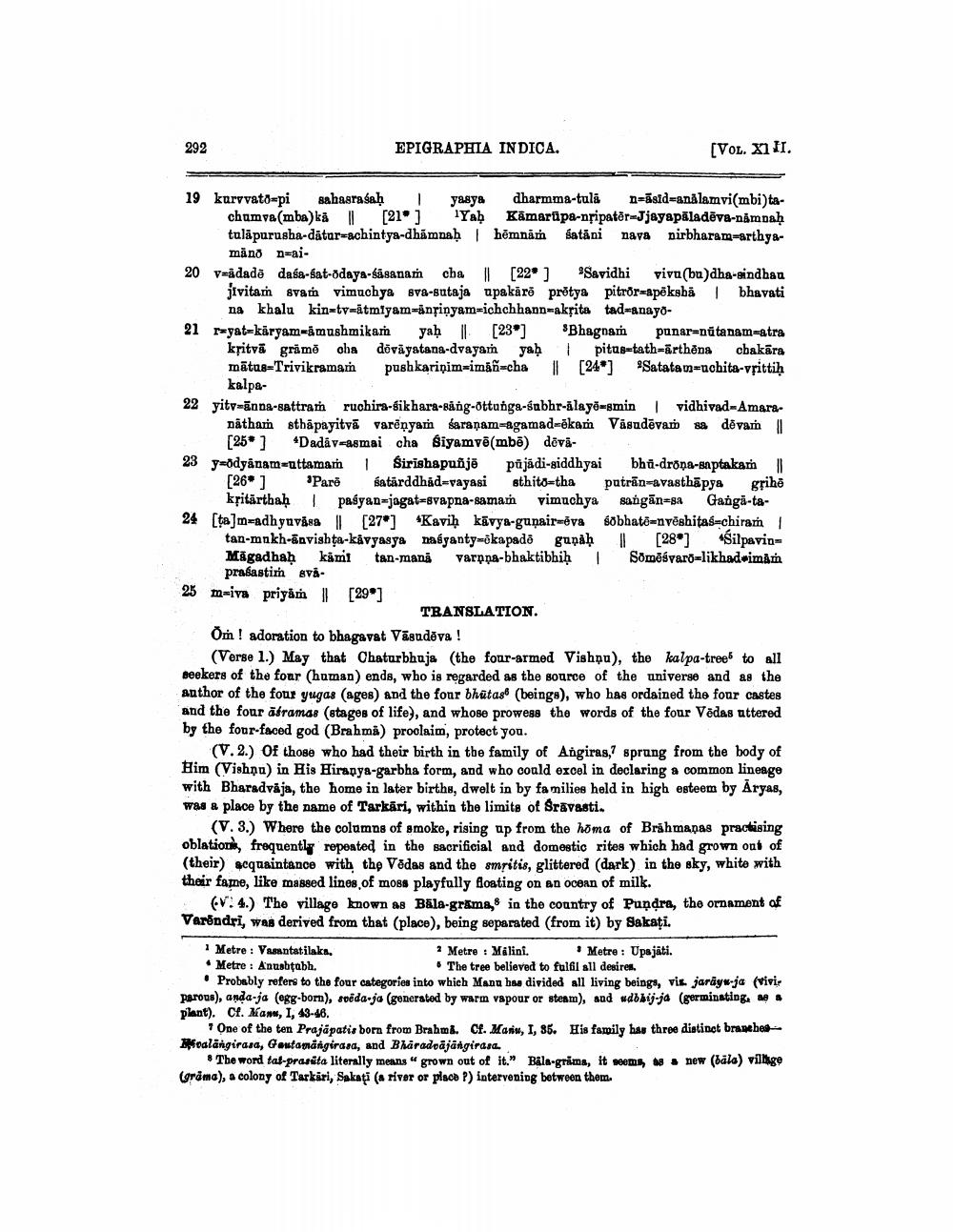________________
292
EPIGRAPHIA INDICA.
[VOL. XI I.
19 kurvvatdwpisahasrasah yasya dharmma-tula D=āsid=análamvi(mbi)ta
chumva (mba)ka [21] Yah Kāmarüpa-npipatēr-Jjayapāladēva-nâmpah tuläpurusha-datar=achintya-dhamnaḥ hēmnāṁ satáni nava nirbharam-arthya
mano n=ai20 v=adadē dasa-Sat-odaya-sâsanam cha || [22] Savidhi vivu (bu)dha-sindhan
jivitam svah vimachya sva-sutaja upakārē prētya pitror=apëkshi | bhavati
na khalu kin=tv=ātmiyam=ansinyam=ichchhann=akrita tad=anayo21 rugat-kāryam-āmushmikaṁ yaḥ | [23] Bhagnań punar=nātanam-atra
kritvã gramo oba dövāyatana-dvayam yaḥ pitus=tath=arthana chakāra mātus-Trivikramam pushkariņim=imāñ=cha [24*] Satatam=nobita-vpittiḥ
kalpa22 yitv-anna-sattram ruchira-Sikhara-sang-Ottunga-sabhr-ālayo=smin | vidhivad-Amara
nåtham sthapayitvā varēnyan saranam-agamad-ěkam Vásudēvam 8 dēvan 11
[25] "Dadáv=asmai cha siyamvē(mbē) dövā23 yaddyanamuuttamarhi Sirishapuñjā půjädi-giddhyai bhu-drona-saptakar II
[26] Paro satarddhád=vayasi sthito-tha patrān=avasthāpya grihe
kpitārthaḥ pasyan-jagat=svapna-samam vimuchya sangān=sa Ganga-ta24 [ta]m-adhyuvasa [27] "Kaviḥ kavya-guņair ēva sobhato=nvēshitas-chiram !
tan-mnkh-anvishta-kavyasya naśyanty=ökapado guṇaḥ [28*] "Silpavin= Magadhaḥ kami tan-maná varpna-bhaktibhiḥ Somēśvarð=likhad imam
prasastim svå25 m=iva priyan | [298]
TRANSLATION. Om ! adoration to bhagavat Vāsudova !
(Verse 1.) May that Chaturbhuja (the four-armed Vishņu), the kalpa-trees to all seekers of the four (human) ends, who is regarded as the source of the universe and as the author of the four yugas (ages) and the four bhūtas (beings), who has ordained the four castes and the four ātramas (stages of life), and whose prowess the words of the four Vēdas uttered by the four-faced god (Brahms) proclaim, protect you.
(V. 2.) Of those who had their birth in the family of Angiras, sprung from the body of Him (Vishna) in His Hirapya-garbha form, and who could excel in declaring a common lineage with Bharadvāja, the home in later births, dwelt in by families held in high esteem by Aryas, was a place by the name of Tarkāri, within the limits of Srāvasti.
(V. 3.) Where the columns of smoke, rising up from the homa of Brāhmaṇas practising oblation, frequently repeated in the sacrificial and domestic rites which had grown out of (their) acquaintance with the Vedas and the smritis, glittered (dark) in the sky, white with their fame, like massed lines of moss playfully floating on an ocean of milk.
(V. 4.) The village known as Bála-grāma, in the country of Pundra, the ornament of Varondri, was derived from that (place), being separated (from it) by Sakati. 1 Metre : Vasantatilaka.
2 Metre : Málini. Metre : Upajati. • Metre : Anushtabh.
* The tree believed to fulfil all desires. Probably refers to the four categories into which Mana has divided all living beings, vis jarāyw.ja (vivi. parous), anda-ja (egg-born), sveda-ja (generated by warm vapour or steam), and wdbkij-ja (germinating, aga plant). Cf. Bana, , 43-46.
One of the ten Prajapatis born from Brahma. Cf. Manu, I, 85. His family has three distinct branches Woalangirasa, Gautamängirasa, and Bharadvajangirasa
The word tal-prasüta literally means "grown out of it." Bala-gráma, it seems, a new (bala) villige (grama), a colony of Tarkari, Sakati (a river or place ?) intervening between them.




